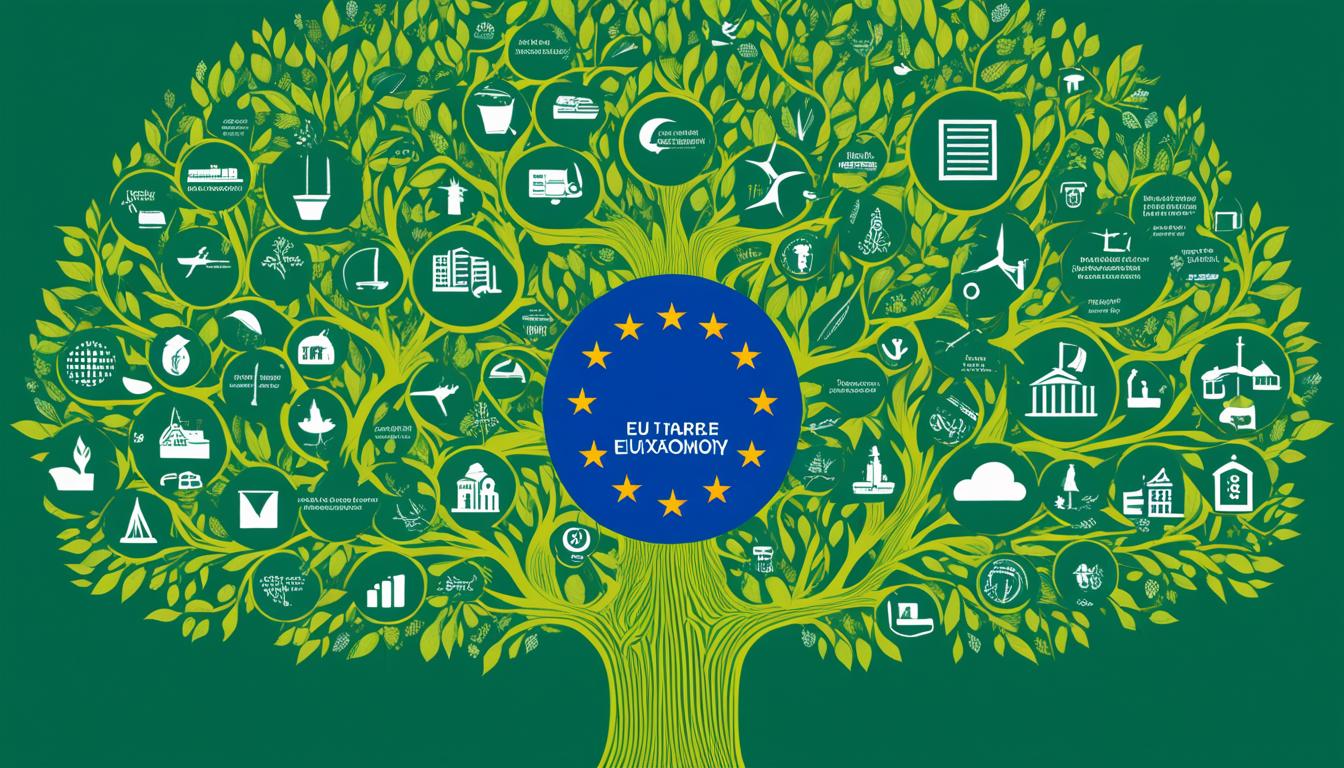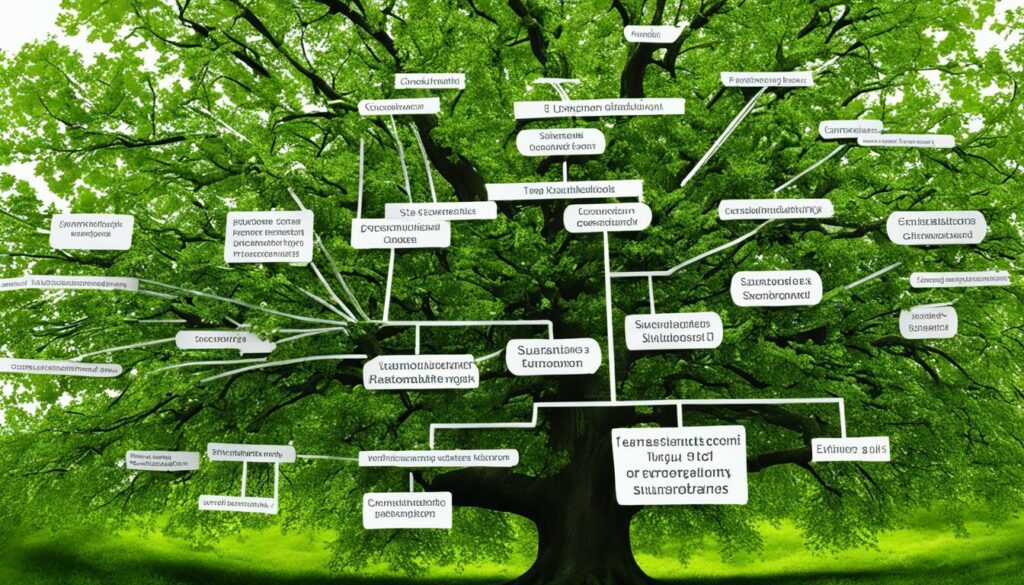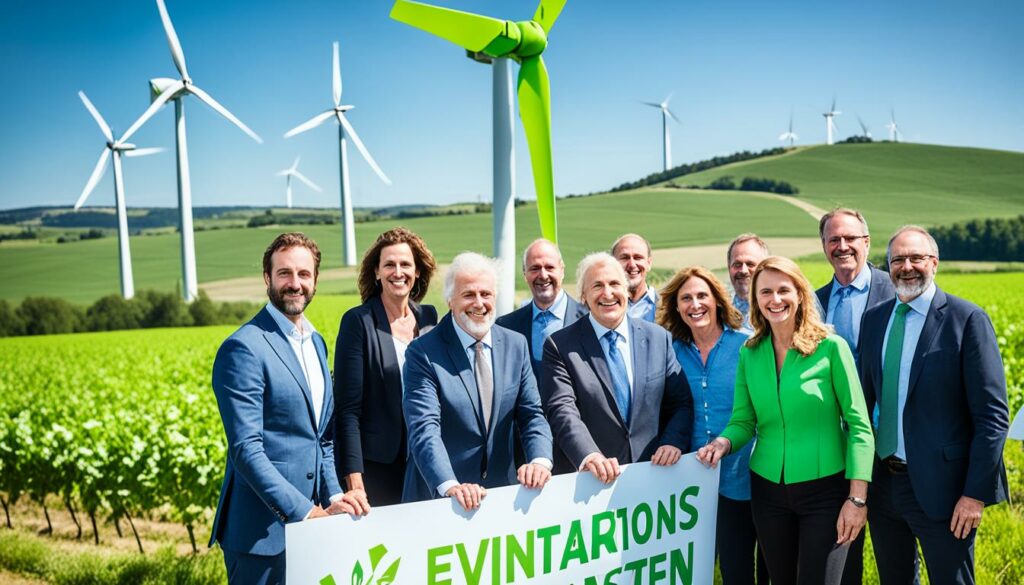Menu

The EU’s goal is to reduce emissions by 55% by 2030. It introduced the EU Taxonomy Regulation on 12 July 2020. This is key for sustainable finance, guiding investments to support the environment and the European Green Deal.
This rule makes sure everyone speaks the same ‘sustainable’ language. It’s a key step in making sure investments truly are green. It also fights against greenwashing, where activities may look good for the environment but are not.
The Taxonomy focuses on six big aims, like fighting climate change and moving to a circular economy. These aims link closely with the Paris Agreement. This helps set strong standards for a cleaner future up to 2050.
For an activity to be green, it must meet four main rules. It must help an environmental goal a lot and not harm the others. Basic social standards must be met. And it must pass some specific checks.
Sustainable investments are key to the EU’s green aims. They help fight climate change by backing projects that meet strict environmentally-friendly standards.
By 2050, the EU wants to cut emissions to zero. Sustainable investments play a huge part in this goal. They fund projects that reduce harmful emissions.
Through green finance, we can back initiatives that are good for the planet. These efforts also help economies grow in a sustainable way.
The Taxonomy Regulation highlights six green goals. It ensures investments protect our planet. It also makes sure these investments do more good than harm.
Even some nuclear and gas projects can be seen as ‘green’ under strict conditions. The EU Parliament agreed on these in July 2022. This shows the depth of the green financing rules.
Sustainable investments aren’t just good for nature. They also boost trust in investors, make markets clearer, and help the green economy grow.
For businesses, meeting the Corporate Sustainability Reporting Directive opens doors. It helps them get green investments. It also shows they care about the environment and community.
By tackling climate change and safeguarding nature, sustainable finance drives economic growth. It helps the move to a low-carbon world.
| Measure | Target | Impact |
|---|---|---|
| Climate Change Mitigation | Zero net emissions by 2050 | Reduction in carbon footprint, enhanced sustainability |
| Environmental Protection | Compliance with six environmental objectives | Prevention of environmental harm, adherence to sustainability standards |
| Economic Benefits | Increased investor trust and transparency | Growth in green financing and sustainable investments |
The EU Taxonomy Regulation is key for sustainable finance. It sets up a clear system to show how green financial and economic activities are. The goal is to help investments align with the EU’s plan to be net-zero by 2050.

In November 2020, the European Commission asked the public for their opinion. They looked over these opinions to create detailed rules. These rules started to be used on January 1, 2022.
There are two main steps. Initially, rules for fighting climate change kicked in from January 1, 2022. Then, from January 1, 2023, more goals for the environment began. This system also sets clear rules for companies that manage investments, affecting how they report their actions.
This law could change how companies think about the environment and social responsibility. Even non-European companies working in the EU will need to follow these new rules.
“The Taxonomy Regulation aims to facilitate green financing by enforcing a standardised EU-wide framework. It ensures that sustainable activities make substantial contributions to at least one of the six environmental objectives without causing significant harm to any other.”
The UK’s decision to keep following these rules after Brexit is still unsure. Without following these, the UK might have different rules.
The EU is aiming to be climate-neutral by 2050, with a big 55% cut in 2030. To help, they’re planning to invest 1 trillion euros in green projects. The EU wants to focus on fighting climate change, using resources wisely, a circular economy, stopping pollution, and protecting biodiversity.
For an activity to be seen as green under these rules, it must help at least one of the eco goals. However, it should not harm the others. This helps ensure that actions are really good for the environment and the world of investing is clearer and more honest.
The EU Taxonomy Regulation launched in July 2020 aims to guide investments into green activities. It creates a system where businesses must meet strict environmental rules. The key goals are fighting climate change, using resources wisely, and stopping pollution.
The EU Taxonomy Regulation helps businesses prepare for climate change. It asks for changes in how we build and plan to reduce climate risks. This approach pushes companies to be more ready for climate challenges. It’s all done with input from experts to make sure plans are good for the future.
Becoming better at using resources wisely is very important under the Taxonomy Regulation. Companies need to show they are careful with resources, supporting big picture goals like moving to a circular economy. Nathan Fabian’s group plays a big role in making sure the right steps are taken. Their work is key to reaching environmental and economic success.
Preventing pollution is a big deal in the EU Taxonomy Regulation. For an activity to be seen as green, it needs to work hard to reduce its pollution. This means using the best methods to cause less harm to the environment. Stricter rules on pollution help us all work towards a safer, greener future.
To be dubbed environmentally sustainable by the EU Taxonomy Regulation, economic actions must meet specific standards. These standards ensure money goes into projects that will really help the planet. Since 12 July 2020, the regulation has demanded tough conditions to call activities green.

The set Technical Screening Criteria decide if an action truly helps the planet. They focus on areas like fighting climate change, saving water, moving to a circular economy, and protecting nature. The European Commission made these criteria to make sure actions don’t harm other eco-goals.
Businesses must stick to these rules to show they are doing good things for the earth.
The rules on what is green come from detailed Technical Screening Criteria set by the Regulation. These criteria say exactly when an activity is good for the environment. The Taxonomy Climate Delegated Act came into effect on 1 January 2022. The Technical Expert Group on Sustainable Finance (TEG), operational from 2018 to 2020, helped create these rules.
The criteria get better with time. In June 2023, the European Commission updated them to contain more actions and fine-tuned the rules. These updates show the Regulation keeps evolving to support green economic efforts.
The EU Taxonomy works to make investments go to truly green projects. It supports big aims like the European Green Deal, which wants Europe to be carbon neutral by 2050. This is how the EU is trying to make our world a better place.
The EU Taxonomy is a key part of the European Green Deal. It directs money towards projects that help achieve a climate-neutral economy by 2050. It came into effect on 12 July 2020 and sets out four main rules for activities to be green.
This system focuses on six big goals for the environment, like tackling climate change. It was published on 22 June 2020. The Technical Expert Group on Sustainable Finance helped create it from 2018 to 2020. This makes the EU Taxonomy a solid guide for green investments.
It’s detailed, with specific rules for each green goal. For example, it checks to make sure investments really lower greenhouse gas emissions. Since January 2023, big companies must show how they fit with the Taxonomy rules. This means they must be clear and follow the environment laws.
Essentially, the Taxonomy helps stop fake green claims and supports a real climate-neutral economy. It boosts both the European Green Deal and trust in truly green projects by investors.
The EU Taxonomy Regulation started on 12 July 2020. It helps with environmental sustainability by giving clear rules for economic activities. It focuses on six big goals, like guarding water resources and moving towards a circular economy.

The EU Taxonomy puts a big emphasis on protecting biodiversity. It aims to make sure investments help save and restore habitats. This means setting tough rules to support projects that benefit natural places and wildlife.
Moving to a circular economy is key for lasting success. The EU Taxonomy boosts activities that cut waste and recycle resources. It guides investments towards projects that follow circular economy principles, making resource use more efficient and sustainable.
The EU Taxonomy navigator makes it easier to understand and use the sustainability criteria. It offers tools like a compass, calculator, FAQs, and a user guide. These help match investments to the Taxonomy’s high environmental standards.
| Environmental Objective | Description |
|---|---|
| Climate Change Mitigation | Actions that contribute to stabilising global climate by reducing greenhouse gas emissions. |
| Climate Change Adaptation | Initiatives aimed at adjusting systems and practices to minimise climate change impacts. |
| Protection of Water Resources | Efforts focused on the sustainable use and protection of water resources. |
| Transition to a Circular Economy | Activities that support resource efficiency, reuse, and recycling. |
| Pollution Prevention | Measures to reduce pollution and minimise harmful environmental impacts. |
| Protection and Restoration of Biodiversity | Actions aimed at conserving and restoring ecosystems and natural habitats. |
The EU Taxonomy Regulation introduces strict disclosure requirements. These affect many companies, not just those in finance. Starting on 12 July 2020, firms must give detailed info about how green their actions are. This aims to make sustainable investment reporting clearer and improve how open companies are.
Requiring ESG disclosures means investors will really know how environmentally and socially sound their investments are. It’s key to making people trust a company’s green promises. Also, it helps the EU’s plan to stop false green claims, which is known as greenwashing.
The Taxonomy Regulation asks companies to shed light on parts of their budgets that match green goals. This includes their fight against climate change and efforts towards recycling.
In Belgium, companies have been following these rules since January 2022. They set an example for others in the EU to do the same.
A helpful EU tool and lots of information, like FAQs, are there to aid companies. They’re meant to clear up any confusion and ensure companies tell the truth about their greenness. This helps build trust with investors.
The EU Taxonomy Regulation started on 12 July 2020. It creates a strong system for green investments. This helps investors know their money is going into eco-friendly projects that meet the EU’s high standards.

It sets a clear definition of what’s green. This makes investors feel more secure. By stating specific conditions, it’s easier to spot real green projects.
This also cuts down the risk of misleading claims. So, investors can trust more in the market.
The Commission offers tools to understand and use the EU Taxonomy. These tools, like the compass, calculator, and FAQ, make it less confusing. They help investors make choices that support the EU’s green goals.
| Tool | Description |
|---|---|
| EU Taxonomy Compass | Guides users through the taxonomy’s criteria and objectives. |
| EU Taxonomy Calculator | Assists in calculating alignment with taxonomy criteria. |
| FAQs Repository | Provides answers to common queries about the taxonomy. |
| User Guide | Offers detailed instructions on complying with the taxonomy. |
The EU Taxonomy helps fight greenwashing. It makes sure that reported green activities are truly eco-friendly. This keeps the market honest and gives investors peace of mind.
Implementing the EU Taxonomy Regulation is hard, especially for companies and banks. The EU Platform on Sustainable Finance found that many face big challenges. They deal with how to use the rules, understand them, and apply them. This is one of the hardest tasks they have to follow.
Understanding the strict rules of the EU Taxonomy is a big challenge for companies. They need to follow these rules quickly but sometimes don’t have enough data or time. For example, asset managers and insurers find it hard to report their Green Investment Ratio correctly.
To help with these challenges, experts suggest having experts check on things. This makes sure the reports about being green are true. It also helps make sure that false claims, or greenwashing, aren’t made.
One big problem with the EU Taxonomy rules is that they can make markets scattered. This means that different markets might use the rules in different ways. The goal was to have one clear system but this isn’t always the case.
To make the most of the EU Taxonomy, everyone involved needs to work together. They need to solve these issues and aim for a clear, shared understanding of how to be sustainable. This way, they can enjoy the benefits of investing in a way that’s good for the planet.
In my search for *sustainable investment case studies*, I found some key examples. They showed how the EU Taxonomy boosts meaningful investments. Mortgage loans in Europe are a great model. The EU Taxonomy standards are now part of funding for new builds and renovations.

Take getting a mortgage for a house as an example. The new home must use at least 20% less energy than the NZEB standard. This proves the EU’s drive for *clean finance* and sustainable lifestyles.
The EU Taxonomy also sets goals for flat refurbishments to save energy. For instance, if a renovation cuts energy use by over 30%, that’s a big win. The success stories highlight *effective investments* in line with green goals.
“By the end of 2021, investors offering funds in Europe branded as ‘environmentally sustainable’ had to disclose the percentage of *taxonomy-aligned investments* within their portfolios.”
Here’s a *detailed table* with the full breakdown of what makes an investment a success:
| Investment Activity | Criteria | Impact |
|---|---|---|
| New Building Construction | 20% lower primary energy demand | Enhanced energy efficiency |
| Building Renovation | 30% reduction in primary energy demand | Lowered energy consumption |
| Acquisition of Pre-2021 Flats | Top 15% local stock energy performance | Superior operational efficiency |
The *Do No Significant Harm (DNSH)* check is vital in these *ESG success stories*. It looks at resilience to extreme weather, efficient water use, good waste management, and using sustainable wood.
From hitting an 80% recycling goal for building waste to tackling pollution by dealing with asbestos, these *sustainable finance cases* show how deep these investments go.
The work by over 40 investor groups in the PRI Taxonomy Practitioners Group stands out. It shows the power of sharing stories and tools to help use the Taxonomy better.
These *ESG success stories* show the Taxonomy can work in practice. They offer great tips for those new to using the Taxonomy in their investments.
Since its start in July 2020, the Taxonomy Regulation has seen big changes. It’s part of the EU’s plan to reach green goals in finance. These changes are helping the EU focus more on environmental and climate objectives.
From the beginning, the Taxonomy Regulation has gone through a number of recent amendments. Notable updates included new guidelines for nuclear and gas businesses, like when they can be considered green. These changes show the EU is willing to adjust to new energy trends to meet its green aims.
For example:
The field of green finance is set for more changes with future legislative proposals. The EU is working on new laws and getting feedback through public talks. This shows a push towards keeping up with the latest in green policies.
The EU is making sure its green finance rules stay strong and open to change. This shows its drive to keep making the Taxonomy Regulation better. The upcoming decisions are key in setting the course for future green policies. They aim to build a more welcoming, green economy in Europe.
The EU Taxonomy’s success is thanks to many working together. Advisory bodies from different areas offered their advice. They helped create the rules for sustainable finance in Europe.

From 2018 to 2020, the Technical Expert Group on Sustainable Finance worked hard. They supported the European Commission. Their work was key to making the EU Taxonomy’s main rules.
Thanks to their effort, we now have clear rules for eco-friendly projects. This helps finance the right kind of activities.
The Platform on Sustainable Finance started in October 2020. It was set up to provide further advice and make the EU Taxonomy better. It is made up of 35 members and 14 observers who are experts from different fields, such as business and academia.
Its main job is to talk about how to make the EU Taxonomy work well. They meet to discuss what needs changing or updating.
The Member States Expert Group looks at how the EU Taxonomy’s rules are working. They make sure these rules fit with each country’s needs. Their hard work makes sure the Taxonomy is useful for all members.
By working together, these groups are improving the EU Taxonomy. They help make sure the rules are clear and match everyone’s goals.
| Advisory Body | Active Period | Key Contributions | Composition |
|---|---|---|---|
| Technical Expert Group | 2018-2020 | Development of legislative proposals | Experts from various sectors |
| Platform on Sustainable Finance | 2020-2022; New mandate from Feb 2023 | Ongoing refinement and implementation advice | 35 members, 14 observers |
| Member States Expert Group | Ongoing | Guidance on legal provisions and national interests | Representatives from EU Member States |
The role of private investors in sustainable finance is key. The Taxonomy Regulation for green investments started on 12 July 2020. It gives private investors a clear path. Now, they know how to make their money help the planet.
This new rule is big for the EU. It lays out what makes an activity friendly to the environment. There are four main things an activity must do to count as green.
This rule is super important for investors. It focuses on six main goals, like helping fight climate change and pollution. Private investors help make sure the money goes where it should. They keep green investments in line with the EU’s big environmental plans.
Investors get help from the EU Taxonomy Navigator. It has tools to make following rules easier. These tools help investors do more than just follow the law. They make sure their money really makes a difference.
Big money is needed to hit the EU’s green goals. Private investors are a huge part of this. They help bring in over EUR 620 billion every year. This money is key to reaching green targets.
But, just investing money is not enough. Investors also need to pick their investments carefully. They must check if companies follow green rules properly. This helps avoid just saying they are green without being real about it.
In the end, private investors’ work with the EU’s green finance rules is vital. They use these rules to help the planet and meet global climate goals. Their efforts are essential for a greener, sustainable future.
The European Commission has created tools to make the EU Taxonomy Regulation easier to understand and use. These tools help people get a grip on the rules and apply them well. A key tool, the ‘EU Taxonomy Navigator’, offers many helpful resources. It speeds up the process for users.
The EU Taxonomy Compass supports both companies and investors. It gives detailed info on what types of activities meet the Taxonomy’s environmental rules. This makes it simpler for businesses to make sure they operate in an eco-friendly way. It boosts trust in green finance practices.
The EU Taxonomy Calculator is vital for calculating how closely a company’s work matches the Taxonomy. It looks at things like turnover and spending. This helps companies report more accurately. It also encourages clearer communication about eco-goals.
The FAQs repository is a treasure trove for answering common questions about the EU Taxonomy. It’s regularly updated to keep users well-informed. This repository helps businesses figure out tricky legal parts. It also shows them the perks of following the Taxonomy.
The EU Taxonomy User Guide is a must-have manual. It describes how to meet the Taxonomy’s demands step-by-step. It’s full of key info, real-life examples, and top methods. This guide is a go-to for anyone aiming to follow the Taxonomy well.
Thanks to tools like the compass, calculator, FAQs, and user guide, the EU simplifies the road to sustainable finance. It ensures that everyone can smoothly embrace the Taxonomy’s strong standards.
The EU Taxonomy Regulation sets up a system that began on 12 July 2020. Its goal is to mark off and explain what activities are good for the environment. This is part of the EU’s plans to use money wisely, meeting tough green standards. The aim is to hit zero carbon emissions by 2050.
Putting money into green projects helps fight climate change and protects nature. These investments also aim to make money while being good for the planet. They help move us towards a future where we use less carbon and more green power.
The Taxonomy Regulation targets stopping climate change, using resources better, lowering pollution, and protecting nature. It’s key to the EU meeting its green goals.
To be called green by the EU Taxonomy, projects must follow strict rules, help with important green goals, and not harm other areas. They’re checked against special criteria to make sure they’re truly good for the environment.
The Taxonomy helps money go towards projects that back the EU’s zero carbon target. It makes sure that the investments we make cut down on harmful gases.
The Taxonomy pushes for saving nature, smarter use of resources, less pollution, and moving towards a circular economy. It ensures all investments line up with big green aims.
Companies must be clear about how green their work is. This helps those investing know if a project fits the EU’s eco-friendly box. It builds trust with people putting their money in such schemes.
The Taxonomy gives investors a roadmap for picking truly green projects. It offers clear definitions and tools to check if an investment is really green. This helps stop false green claims and guides better investment choices.
Big challenges include sticking to tough criteria and making sure everyone talks the same language. Solving these hurdles is key to using the Taxonomy to its full green potential.
Looking at how well green investments have done can show us what works. These success stories prove that the Taxonomy is moving us closer to big eco-goals.
New steps include allowing some nuclear and gas activities if they are very green. The EU keeps working on ways to make the Taxonomy better and clearer.
The process got help from experts, financial advice groups, and governments. They have been giving advice all along to make the Taxonomy strong and useful.
Investors have a big part in making green projects happen. The Taxonomy guides them, making their choices good for the climate and business. This helps grow investment in green projects.
There are many tools like the Taxonomy Navigator, compass, and calculator to help understand and use the rules. They help companies and investors follow the Taxonomy well.